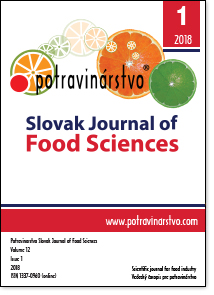Hypolipidemic action of the meat product: in vivo study
DOI:
https://doi.org/10.5219/959Keywords:
meat product, lipids, hyperlipidemia, apolipoproteins, cholesterolAbstract
Results of meat product influence on the serum lipid profile of hyperlipidemic rats are presented. Meat product for specialized nutrition content porcine aortas and hearts in ratio 1:3. Thirty male Wistar rats (380 ±20 g) aged approximately 1 year were kept in conventional standard conditions; water and feed were available ad libitum. Animals were randomly divided in 3 groups: group 1 - negative control (n=10); group 2 - positive control (n=10) and group 3 - experimental animals (n=10). Animals in group 2 and 3 were modeled an alimentary hyperlipidemia by adding cholesterol, fat and vitamin D2 into diet. After modeling, rats in group 2 were fed with standard chow, in group 3 - meat product (8g/kg b.w.) with standard chow. On the 42nd day serum lipid profile was investigated and immunoassay was carried out. It was found that the developed meat product given to the hyperlipidemic rats led to a decrease in the concentration of cholesterol, triglycerides and atherogenic fractions of lipoproteins by 31.8% (p <0.05), 28.2% and 2.4 times (p <0.05), respectively. Estimation of the concentration changes in apolipoproteins, forming lipoprotein particles, allowed to indirectly determining the main lipoprotein reduction that contributed to the total decrease in the atherogenic index of serum, which reached 41.3% (p <0.05). Previous proteomic study revealed the presence of a number of specific proteins and peptides in tissues of porcine aortas and heart. The hypothesis that tissue-specific proteins could decomposed into active peptides with antiatherogenic action is considered.
Downloads
Metrics
References
Ahhmed, A. M., Muguruma, M. 2010. A review of meat protein hydrolysates and hypertension. Meat Science, vol. 86, no. 1, p. 110-118. https://doi.org/10.1016/j.meatsci.2010.04.032 DOI: https://doi.org/10.1016/j.meatsci.2010.04.032
Arihara, K. 2006. Strategies for designing novel functional meat products. Meat Science, vol. 74, no. 1, p. 219-229. https://doi.org/ https://doi.org/10.1016/j.meatsci.2006.04.028 DOI: https://doi.org/10.1016/j.meatsci.2006.04.028
Arihara, K., Ohata, M. 2011. Functional foods: concept to products. In Functional Foods. 2nd ed. Cambridge: Woodhead Publishing, UK, p. 512-533. ISBN: 978-1-84569-690-0. https://doi.org/10.1533/9780857092557.3.512 DOI: https://doi.org/10.1533/9780857092557.3.512
Bauchart, C., Rémond, D., Chambon, C., Patureau Mirand, P., Savary-Auzeloux, I., Reynès, C., Morzel, M. 2006. Small peptides (<5 kDa) found in ready-to-eat beef meat. Meat Science, vol. 74, no. 4, p. 658-666. https://doi.org/ https://doi.org/10.1016/j.meatsci.2006.05.016 DOI: https://doi.org/10.1016/j.meatsci.2006.05.016
Camejo, G., Hurt-Camejo, E. 2014. Macrophages, extracellular matrix, and lipoproteins in arterial cholesterol balance. Journal of Lipid Research, vol. 55, no. 1, p. 1-3. https://doi.org/ https://doi.org/10.1194/jlr.E045732 DOI: https://doi.org/10.1194/jlr.E045732
Chernukha, I. M., Fedulova, L. V., Kotenkova, E. A. 2014. Study on the molecular-biological principles of hypolipidemic activity of cardiac and aortic tissues of pigs and cattle. Archivos Latinoamericanos de Produccion Animal, vol. 22, no. 5, p. 22, 594-597.
Chernukha, I. M., Fedulova, L. V., Kotenkova, E. A. 2015. Meat by-product is a source of tissue-specific bioactive proteins and peptides against cardio-vascular diseases. Procedia Food Science, vol. 5, p. 50-53. DOI: https://doi.org/10.1016/j.profoo.2015.09.013
Chernukha, I. M., Fedulova, L. V., Kotenkova, E. A., Shishkin, S. S., Kovalyov, L. I., Mashentseva, N. G., Klabukova, D. L. 2016 Influence of heat treatment on tissue specific proteins in the Sus Scrofa cardiac muscle and aorta. Russian Journal of Biopharmaceuticals, vol. 8, no. 6, p. 38-44.
Fagerberg, L., Hallström, B. M., Oksvold, P., Kampf, C., Djureinovic, D., Odeberg, J., et al. 2014. Analysis of the human tissue-specific expression by genome-wide integration of transcriptomics and antibody-based proteomics. Molecular and Cellular Proteomics, vol. 13, no. 2, p. 397-406. https://doi.org/ https://doi.org/10.1074/mcp.M113.035600 DOI: https://doi.org/10.1074/mcp.M113.035600
Huang, C., Cen, C., Wang, C. X., Zhan, H., Ding, X. 2014. Synergistic effects of colchicine combined with atorvastatin in rats with hyperlipidemia. Lipids in Health and Disease, vol. 13, no. 67, p. 1-6. https://doi.org/10.1186/1476-511X-13-67 DOI: https://doi.org/10.1186/1476-511X-13-67
Hui, Y. H. 2012. Handbook of Meat and Meat Processing. 2nd ed. USA : Taylor & Francis Group. 1000 p. ISBN 9781439836835. https://doi.org/10.1201/b11479 DOI: https://doi.org/10.1201/b11479
Kotenkova, E. A. 2017. The study of substances contained in porcine aorta tissues for creation of functional food additive. Issues of nutrition, biotechnology and food safety. Russia : Federal Reseach Centre of Nutrition and Biotechnology. 302 p. ISBN 978-5-9909049-1-0.
Lafarga, T., Hayes, M. 2014. Bioactive peptides from meat muscle and by-products: generation, functionality and application as functional ingredients. Meat Science, vol. 98, no. 2, p. 227-239. https://doi.org/10.1016/j.meatsci.2014.05.036 DOI: https://doi.org/10.1016/j.meatsci.2014.05.036
Lyapina, L. A., Grigor'eva, M. E., Obergan, T. Y., Shubina, T. A., Andreeva, L. A., Myasoedov, N. F. 2015. Peptide regulation of metabolic processes under hypercholesterinemia conditions of an organism. Biology Bulletin, vol. 42, no. 6, p. 546-555. https://doi.org/10.1134/S1062359015060060 DOI: https://doi.org/10.1134/S1062359015060060
Mangilova, T. O. 2012. The system of vascular endothelial growth factor and hypertension. Heart and Vessels, vol. 41, p. 107-115.
Mine, Y., Shahidi, F. 2006. Nutraceutical Proteins and Peptides in Health and Disease. USA : Taylor & Francis Group, CRC Press. 688 p. ISBN 9781420028836. DOI: https://doi.org/10.1201/9781420028836
Olofsson, S. O., Wiklund, O., Borén, J. 2007. Apolipoproteins A-I and B: biosynthesis, role in the development of atherosclerosis and targets for intervention against cardiovascular disease. Vascular Health and Risk Management, vol. 3, no. 4, p. 491-502. PMid:17969379
Seidova, G. B. 2005. C-reactive protein and its correlation with metabolic syndrome associated with coronary heart disease in women in pre- and postmenopausal women. Bulletin of Arrhythmology, no. 41, p. 47-50.
Swirski, F. K., Robbins, C. S. 2013. Neutrophils Usher Monocytes Into Sites of Inflammation. Circulation Research, vol. 112, no. 5, p. 744-745. https://doi.org/10.1161/CIRCRESAHA.113.300867 DOI: https://doi.org/10.1161/CIRCRESAHA.113.300867
Toldrá, F., Aristoy, M. C., Mora, L., Reig, M. 2012. Innovations in value-addition of edible meat by-products. Meat Science, vol. 92, 290-296. https://doi.org/10.1016/j.meatsci.2012.04.004 DOI: https://doi.org/10.1016/j.meatsci.2012.04.004
Udenigwe, C. C., Howard, A. 2013. Meat proteome as source of functional biopeptides. Food Research International, vol. 54, no. 1, p. 1021-1032. https://doi.org/10.1016/j.foodres.2012.10.002 DOI: https://doi.org/10.1016/j.foodres.2012.10.002
Weiss, J., Gibis, M., Schuh, V., Salminen, H. 2010. Advances in ingredient and processing systems for meat and meat products. Meat Science, vol. 86, no. 1, p. 196-213. https://doi.org/10.1016/j.meatsci.2010.05.008 DOI: https://doi.org/10.1016/j.meatsci.2010.05.008
Downloads
Published
How to Cite
Issue
Section
License
This license permits non-commercial re-use, distribution, and reproduction in any medium, provided the original work is properly cited, and is not altered, transformed, or built upon in any way.






























